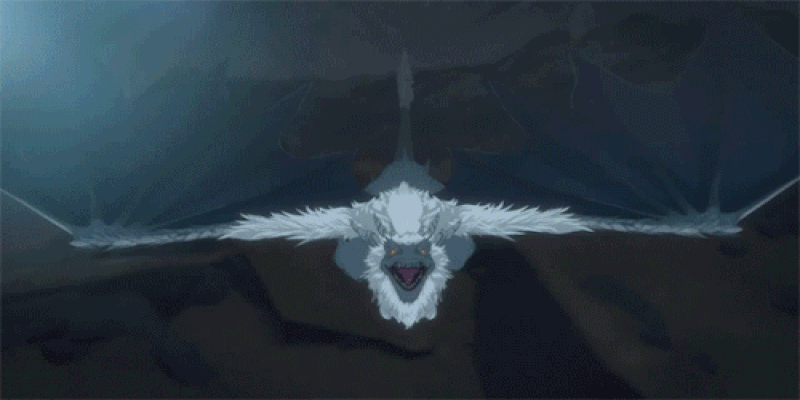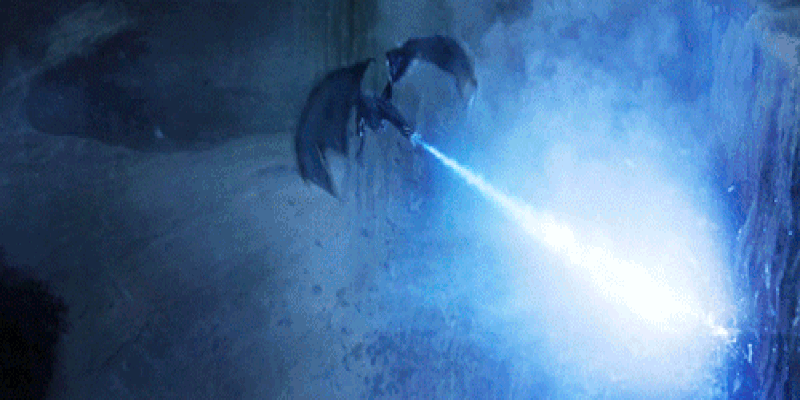Exploring the Possibility of Dragons: Lightning and Ice Attacks
Written on
This article marks the second part of a trilogy discussing the biological feasibility of dragons. Previously, I argued that dragons could achieve flight if they possessed anatomy similar to that of certain prehistoric pterosaurs. Additionally, I detailed the requirements for fire breathing. In this installment, I will delve into the potential for dragons to wield lightning or ice as offensive capabilities instead of fire. For continuity, the first post in the series is included below.
Could a Dragon Generate Lightning?

For a dragon to unleash lightning, it must develop three critical adaptations: a mechanism to generate substantial electricity, a means to direct the electrical discharge, and a safeguard against self-electrocution. A logical starting point is to examine existing creatures capable of electrical attacks. Can you guess which one?
Electric eels are known to produce enough electricity to incapacitate a horse. This electricity is created through the same biological process found in other organisms: they move sodium ions to one side of their cell membranes and potassium ions to the opposite side, resulting in an electrical imbalance. When these ions return to equilibrium, an electrical discharge occurs. Electric eels possess specialized cells called electrocytes dedicated to generating electricity. Each electrocyte can produce 0.15 volts, and a unique nerve cluster coordinates the release of ions across thousands of these cells, enabling a significant electrical output.

Air is a poor conductor of electricity; it requires 3 million volts to navigate just one meter of air. Using this information, we can determine how many electrocyte cells a dragon would need to overcome a substantial air gap. If a dragon could launch its lightning strike up to 45 feet (the same range as the fire-breathing dragon discussed earlier), it would require over 41 million volts, necessitating more than 270 million electrocyte cells. These cells would need to shift approximately 0.73 kilograms of sodium and 0.83 kilograms of potassium, which do not require replacement after each discharge, allowing the dragon to maintain flight capability without hindrance.
To control the path of lightning, the dragon could create an area of lower electrical resistance in the air. For instance, by expelling a conductive liquid like salt water towards its target, the dragon could guide the lightning's trajectory. In my previous article, I discussed how a dragon might compress gas within its body to expel liquids at high speeds, thus providing a method for ejecting salt water.
The dragon would likely also produce chemicals to enhance the viscosity of the expelled liquid, ensuring a more streamlined flow. Any disruption in the stream could diminish the electrical current. Ideally, the saltwater stream would reach its target directly, minimizing the need for the lightning to arc through the air, although some sparking might still occur.
Another potential method for guiding electrical flow could involve fire. Fire is partially a plasma, meaning some atoms are ionized, making it more conductive than air. Therefore, the dragon could breathe fire towards its target, creating a pathway for the lightning.
This method would produce a fascinating phenomenon where the electromagnetic field from the lightning accelerates free electrons within the flames, causing them to collide with other electrons and liberate them from their atoms. This cascade effect would transform the fire from a partial plasma into a full plasma—imagine a dragon that breathes plasma!

However, all these adaptations would be futile if the dragon could not protect itself from its own electrical discharges. Electric eels avoid self-harm through short shock durations, insulating tissues, and the fact that electricity prefers to travel through water rather than through their bodies. Unfortunately, our lightning dragon cannot rely on the last factor due to air's poor conductivity. Thus, it must find alternative protection methods, such as utilizing the skin effect.
The skin effect refers to the phenomenon where electricity flows along the outer edges of a conductor when alternating current is applied, creating eddy currents. This is why there is a high survival rate for lightning strikes; the electricity flows around the body rather than through vital organs. If our dragon's electrical discharge exhibited a strong skin effect due to rapid voltage changes, it would shield its vital organs by ensuring the electricity flowed along its exterior layers. These layers could consist of a conductive material with low resistance compared to the dragon's body, such as graphene, which I previously suggested would be necessary for a fire dragon's metabolic processes.

In summary, a dragon could theoretically harness lightning by mimicking the biology of an electric eel, directing either salt water or flames towards its intended target, and generating electricity with a pronounced skin effect. Moreover, it would benefit from having a conductive outer layer, insulating tissues internally, and capable of rapid electrical discharges. The electrocyte cells should ideally be situated near the skin's surface to minimize the distance the electricity must travel through flesh before reaching the conductive layer.
Could a Dragon Freeze Its Targets in Ice?

To create ice, a dragon must effectively cool down water after expelling it; otherwise, it risks freezing itself. Rapid movement through air can lead to convective cooling, so if the water can be ejected quickly enough, it may freeze upon exit. For instance, if a dragon wishes to generate 10 cubic meters of ice, that equates to 9170 kilograms of water, indicating that ice-breathing dragons would need considerable mass.
The dragon would likely source its water from a location like the Arctic Ocean, where the seawater is already near freezing. Arctic seawater averages about 3.00°C, with a specific heat capacity of 3850 J/(kg°C) and a latent heat of fusion of about 330 kJ/kg. To freeze 9170 kilograms of this water, the dragon would need to remove 177 megajoules of thermal energy to cool it to -2°C and an additional 3071 megajoules for the transition from liquid to solid. This totals approximately 3248 megajoules that the dragon must extract from the seawater it expels. Assuming an air temperature of -35°C, the water could remain airborne for a second before freezing, establishing a direct correlation between the ejection speed and its contact area with the air.
The equation I’m using applies to speeds of 20 m/s or below. At 20 m/s, water would not freeze unless it had a significant contact area with the air, which I estimate would need to exceed 70 million square meters. This may appear excessive for 10 cubic meters of water, but the water would be dispersed into numerous fine droplets.

In reality, this means the dragon would be launching an icy mist towards its targets rather than encasing them in ice. It’s essential for our snow dragon to evolve a mechanism for breaking up water droplets as they leave its throat.

Additionally, snow dragons would need significant size to propel that much water quickly. For instance, if it could accelerate 9170 kilograms of water from 0 to 20 m/s in a tenth of a second, it would need to exert over 1.8 million newtons of force—around 21 times the strength of an elephant. This calculation does not account for air resistance. According to the square-cube law, the strength ratio of two animals with similar proportions can be estimated as the square of the ratio of their lengths, which itself is the cube root of their mass ratio. Using this principle, we can estimate the mass of our snow dragon if its proportions matched those of an elephant.
An African bush elephant weighs about 7.7 US tons, suggesting our snow dragon would weigh around 741 US tons—3.7 times heavier than the largest blue whales, making terrestrial movement improbable. For the snow dragon to remain a land creature, it must be lighter, ideally matching the largest terrestrial animals, such as Argentinosaurus, which weighed up to 57 US tons. A dragon of this size would only be about 3.8 times stronger than an elephant, limiting its water ejection capacity to about 1628 kilograms, producing only 1.8 cubic meters of ice. However, this reduction would significantly decrease the surface area requirement, resulting in larger flakes of icy mist. Faster water expulsion could further lessen the surface area, but would require additional force, potentially reducing the amount of water that could be frozen.
It's also possible that our snow dragon could employ a different strategy to incapacitate its targets using cold. Jets of extremely cold water could trigger cold shock responses, similar to how humans react when submerged in water at 15°C or lower. This response can incapacitate or even kill a person, suggesting that one should be wary of a snow dragon's wrath. This cold shock method could be effective against any creature exhibiting a comparable reaction.

In summary, a large, non-flying dragon could unleash fast-moving seawater that cools into a mist before reaching its target. However, these sprays would be widely dispersed, limiting potential damage. An alternative approach for snow dragons could involve using jets of cold water to simultaneously shock and disorient their targets. They might also create large snow mounds and gradually freeze their victims in place by spraying water on the snow piles. Such dragons would thrive in climates akin to the Arctic, where both seawater and air temperatures are frigid.
Can a Dragon Breathe Cold Fire?

In short, no. Fire is inherently an exothermic process, meaning it releases heat. However, a dragon could potentially expel a cold substance that resembles fire. Recall that fire can exist as a partial plasma. Any gas can be converted into a partial plasma by ionizing some of its electrons. While the electrons must reach high temperatures for this process, the atomic nuclei do not. Since electrons possess minimal mass relative to atomic nuclei, they contribute insignificantly to the temperature of a plasma. Thus, ionizing a cold gas produces cold partial plasma that visually appears like fire!
We have previously discussed how a dragon could generate sufficient electricity to ionize gases, but it must also have a method for cooling these gases. Let’s take argon as an example. Argon is the third most prevalent gas in Earth’s atmosphere and does not react chemically with others. Additionally, it emits a light blue or violet glow when electrified, which adds to its allure.
To induce mild hypothermia in a large animal like a cow, the argon jet would need to be sufficiently cold. Hypothermia in cows occurs below 32°C, while their normal body temperature is at least 37.8°C, with weights reaching up to 1088 kilograms. With a specific heat capacity of 3440 J/(kg°C), our dragon would have to extract about 22 megajoules of energy from the cow’s body. Using equations for convective cooling, assuming maximum heat transfer efficiency and optimal surface area, it would take significantly longer than half an hour to induce hypothermia, even if the argon jet were nearly at absolute zero. This proves to be an inefficient offensive method.
Even if the cold partial plasma could instigate a cold shock response, several challenges remain. First, the advantage of converting the argon jet into a partial plasma is unclear; this would merely raise the temperature of the particles meant to be cold and would make the jet more visible and easier to evade. Furthermore, the dragon would need to store an impractical amount of argon gas, which is difficult to isolate due to its unreactive nature. Ultimately, the argon jet would likely disperse and warm before reaching its target. Therefore, while a cold fire dragon is an intriguing concept, it appears improbable to exist.
Conclusion
In conclusion, can dragons attack with lightning or ice? For lightning, we can envision a dragon evolving to discharge substantial electricity using mechanisms akin to those of electric eels. It would also need to leverage the skin effect to shield itself from its own electricity while aiming its discharge by expelling saltwater or flames towards its target. Regarding ice, we can imagine a massive dragon that ingests large quantities of seawater and expels it rapidly enough to freeze through convective cooling, resulting in a blast of icy mist. This dragon would need to inhabit a cold environment where both air and water temperatures are already low. I would argue that both these dragons are as likely to evolve as fire-breathing ones, if not more so. Understanding their potential biological functions only adds to their intrigue.
Works Cited
Steele, Z. (2020, October 05). Could Dragons Exist? — Pt. 1. Retrieved October 05, 2020, from https://readmedium.com/could-dragons-exist-pt-1-4479113fb50b
Staff, R. (2018, October 25). Electric Eels Can Generate Enough Shock to Take Down a Horse. Retrieved October 05, 2020, from https://roaring.earth/electric-eel-doubles-shocking-power/
Hourigan, A. (Producer). (2016). The SCIENCE! — Exactly how OVERPOWERED is Pikachu? [Video file]. Retrieved October 4, 2020, from https://www.youtube.com/watch?v=OWTpCSyHPNw
How do electric eels generate a voltage and why do they not get shocked in the process? (2005, December 05). Retrieved October 05, 2020, from https://www.scientificamerican.com/article/how-do-electric-eels-gene/
Eels and humans have something in common — they’re both ELECTRIC! (2019, May 27). Retrieved October 05, 2020, from https://www.mcgill.ca/oss/article/did-you-know/where-do-electric-eels-get-their-electricity
Elert, G. (2000). Dielectric Strength of Air. Retrieved October 05, 2020, from https://hypertextbook.com/facts/2000/AliceHong.shtml
Lightning Facts and Information. (2009, October 09). Retrieved October 05, 2020, from https://www.nationalgeographic.com/environment/natural-disasters/lightning
Electric Eel. (2018, September 21). Retrieved October 05, 2020, from https://www.nationalgeographic.com/animals/fish/e/electric-eel/
David, I. (2019, March 02). Why Salt in Water Can Conduct Electricity. Retrieved October 05, 2020, from https://sciencing.com/salt-water-can-conduct-electricity-5245694.html
Fixing one of Mythbusters Biggest Mistakes. (2021). Allen Pan. Retrieved August 18, 2022, from https://www.youtube.com/watch?v=lHVkCyFo5mY.
Muller, D. (Producer). (2012, September 11). What’s In A Candle Flame? [Video file]. Retrieved October 4, 2020, from https://www.youtube.com/watch?v=a7_8Gc_Llr8&t=1m6s
Orgill, J. J. (Producer). (2017, July 20). Making a Mini Sun in a Microwave! Microwaving Fire to Make Plasma in My Top Secret Microwave [Video file]. Retrieved October 4, 2020, from https://www.youtube.com/watch?v=rLB_iHmFSeU
Build a Saltwater Circuit. (n.d.). Retrieved October 05, 2020, from https://www.homesciencetools.com/article/saltwater-circuit-project/
Hill, K. (Producer). (2019, June 20). Why Thor ISN’T Immune to Electricity [Video file]. Retrieved October 4, 2020, from https://www.youtube.com/watch?v=sEF5UNyC4DU&t=739s
Reich, H. (Producer). (2013, September 9). How to Survive a Lightning Strike [Video file]. Retrieved October 4, 2020, from https://www.youtube.com/watch?v=eNxDgd3D_bU&hd=1
Talley, L. (2000). SIO 210 Talley Topic 2. Retrieved October 05, 2020, from http://sam.ucsd.edu/sio210/lect_2/lecture_2.html
Illsley, C. (2018, November 13). How Cold Is The Arctic Ocean? Retrieved October 05, 2020, from https://www.worldatlas.com/articles/how-cold-is-the-arctic-ocean.html
Libretexts. (2020, September 08). 10.10: Enthalpy of Fusion and Enthalpy of Vaporization. Retrieved October 05, 2020, from https://chem.libretexts.org/Bookshelves/General_Chemistry/Book:_ChemPRIME_(Moore_et_al.)/10:_Solids_Liquids_and_Solutions/10.10:_Enthalpy_of_Fusion_and_Enthalpy_of_Vaporization
Kent. (n.d.). Retrieved October 05, 2020, from http://www.kentchemistry.com/links/Energy/HeatFusion.htm
Thermal Physics — Lesson 2 Calorimetry. (n.d.). Retrieved October 05, 2020, from https://www.physicsclassroom.com/class/thermalP/Lesson-2/Measuring-the-Quantity-of-Heat
Hill, K. (Producer). (2019, January 24). Why You Don’t Want the Power of Flight [Video file]. Retrieved October 4, 2020, from https://www.youtube.com/watch?v=qP-2hMNnhgY
Engineering ToolBox, (2003). Convective Heat Transfer. [online] Available at: https://www.engineeringtoolbox.com/convective-heat-transfer-d_430.html [Accessed 4 Oct. 2020].
Overland, J. E. (2018, December 06). Surface Air Temperature. Retrieved October 05, 2020, from https://arctic.noaa.gov/Report-Card/Report-Card-2018/ArtMID/7878/ArticleID/783/Surface-Air-Temperature
Hill, K. (Producer). (2018, April 19). Why You Don’t Want Super Speed [Video file]. Retrieved October 4, 2020, from https://www.youtube.com/watch?v=FTEDZQaEIts
Taylor, D. (2020, February 08). Antarctica Sets Record High Temperature: 64.9 Degrees. Retrieved October 05, 2020, from https://www.nytimes.com/2020/02/08/climate/antarctica-record-temperature.html
Weather in Alaska. (2020, June 18). Retrieved October 05, 2020, from https://alaskatours.com/alaska-first-time-visitors/weather-in-alaska/
Strongest Animals In The World: 15 Strongest By Power & Bite. (2020, September 07). Retrieved October 05, 2020, from https://safarisafricana.com/strongest-animals-in-the-world/
African Elephant Facts. (n.d.). Retrieved October 05, 2020, from https://www.elephantsforafrica.org/elephant-facts/
Black, R. (2020, October 13). Why the World’s Biggest Dinosaurs Keep Getting Cut Down to Size. Retrieved December 25, 2020, from https://www.scientificamerican.com/article/why-the-worlds-biggest-dinosaurs-keep-getting-cut-down-to-size/
Orgill, J. J. (Producer). (2019, May 6). How to Make a Cold Fire Torch That You Can Touch and Not Get Burned! [Video file]. Retrieved October 4, 2020, from https://www.youtube.com/watch?v=DnSRbnvm798
Orgill, J. J. (Producer). (2019, May 21). Making Fire That Actually Freezes Things Instead of Burns Them — Cold Fire Part 2 [Video file]. Retrieved October 4, 2020, from https://www.youtube.com/watch?v=cUpv2AqbZ1E
The Element Argon. (n.d.). Retrieved October 05, 2020, from https://education.jlab.org/itselemental/ele018.html
Paschen’s law. (2020, May 05). Retrieved October 05, 2020, from https://en.wikipedia.org/wiki/Paschen's_law
Ministry of Agriculture, Food and Rural Affairs. (n.d.). Retrieved October 05, 2020, from http://www.omafra.gov.on.ca/english/livestock/beef/facts/07-001.htm
Elert, G. (1998). Temperature of a Healthy Cow. Retrieved October 05, 2020, from https://hypertextbook.com/facts/1998/PeiJunChen.shtml
Muthukumarappan, K., Marella, C., & Sunkesula, V. (2019, June 21). Food Freezing Technology. Retrieved October 05, 2020, from https://www.sciencedirect.com/science/article/pii/B9780128148037000154
Cozler, Y., Allain, C., Xavier, C., Depuille, L., Caillot, A., Delouard, J., . . . Faverdin, P. (2019, August 28). Volume and surface area of Holstein dairy cows calculated from complete 3D shapes acquired using a high-precision scanning system: Interest for body weight estimation. Retrieved October 05, 2020, from https://www.sciencedirect.com/science/article/abs/pii/S0168169919313456
The cold shocking truth…. about cold water shock. (n.d.). Retrieved October 05, 2020, from https://www.rya.org.uk/newsevents/e-newsletters/up-to-speed/Pages/the-cold-shocking-truthabout-cold-water-shock-.aspx
Eglin, C., Butt, G., Howden, S., Nash, T., & Costello, J. (2015, September 14). Rapid habituation of the cold shock response. Retrieved October 05, 2020, from https://www.ncbi.nlm.nih.gov/pmc/articles/PMC4580772/
Blue whale. (2020, June 09). Retrieved December 25, 2020, from https://www.nationalgeographic.com/animals/mammals/b/blue-whale/
Electric eel. (2021, January 05). Retrieved January 08, 2021, from https://en.wikipedia.org/wiki/Electric_eel
Roy, A., Royer, A., Montepetit, B., Bartlett, P. A., & Langlois, A. (2012, December 18). Snow specific surface area simulation in the classA. The Cryosphere Discussions. Retrieved February 9, 2022, from https://tc.copernicus.org/preprints/6/5255/2012/tcd-6-5255-2012.pdf